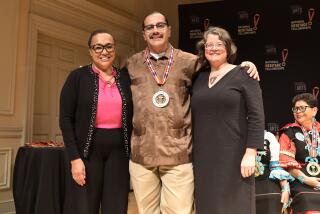Only Skin Deep : Foundation Helps Ex-Gang Members Erase Tattoos of Their Past
- Share via
Katie, 17, held one arm, trembling, red and swollen, across her lap. She waited with plastic wrap over her brow for another treatment that promised to further liberate her from what Dr. Adrianna Scheivner says imprisons some people in their own skins--tattoos.
Scheivner, president and founder of Brave Hearts, a nonprofit foundation providing medical cosmetic services to needy youths, is a laser dermatology specialist with a practice in Beverly Hills.
Katie is an ex-gang member currently incarcerated at Camp Scott, a facility for young women in the Santa Clarita Valley.
On Friday, Katie and about 40 of her compatriots--eager but nervous--waited in one of the camp’s makeshift outbuildings to be anesthetized, zapped with a laser and then slathered with fruit acid by Scheivner’s cheerful crew of assistants and volunteers.
Scheivner had already slowly guided the laser over a series of flowers and spider webs on Katie’s arm. As the acid helped draw the ink from her skin, Katie waited for the anesthetic to numb her forehead, where “Suis,” a gang name, and “Love” were written in script above each eyebrow.
Although Brave Hearts makes regular visits to the California Youth Authority’s Oxnard facility, Friday marked its first visit to this minimum-security juvenile facility, and most of the young women here were anxious to erase as much of their past as possible. Some had gotten their markings in tattoo shops, others applied the gang names, roses and marijuana leaves themselves, using India ink and homemade contraptions.
Nancy, an 18-year-old resident at the camp, has been trying to get rid of her tattoos--which start at her face and trickle down the rest of her body--for a few years now.
“After I got out the last time,” said Nancy, who has been arrested 18 times, “I tried to be good. I wanted to be straight. . . . But people could just look at me and know I’ve lived a gang life.”
With only a four-month break, Nancy has been on probation or locked up since she was 11. About a year ago, she resolved to take off her tattoos. She began saving money to have a doctor remove them but became discouraged when the savings grew slowly.
“I have a son to take care of,” she said--a son who constantly asks, “What’s that, Mom. What is that?” So Nancy held a flame under a kitchen spoon, heating it “for a long time.” Then she pressed it against her cheekbone, just below her left eye.
“I thought I could burn them off,” she says of the teardrops and three dots at the corner of her eye, a design that, in gang parlance, signifies mi vida loca, or my crazy life. Instead, she says, the side of her face swelled up and “got pretty infected.” But, at least, she could cover the scars with makeup.
Nancy’s story illustrates, Scheivner said, why she volunteers her services at facilities such as Camp Scott.
“These . . . marks all over their bodies are constant reminders of where their lives have been and what other people see when they look at them,” she said.
The stench of laser-burned hair mixed with the smell of the tuna salad sandwiches the young women were served in the narrow hallway. Most will need six or eight more sessions for Scheivner to erase their tattoos, and even then, some faint scars may remain.
Once they are released from Camp Scott, Scheivner promises to continue treating them for free.
“I just can’t even believe this is happening,” Nancy said stoically, trying to ignore the pain. With a half-smile, she said:. “I am going to be able to go to PTA meetings someday.”
More to Read
Sign up for Essential California
The most important California stories and recommendations in your inbox every morning.
You may occasionally receive promotional content from the Los Angeles Times.










